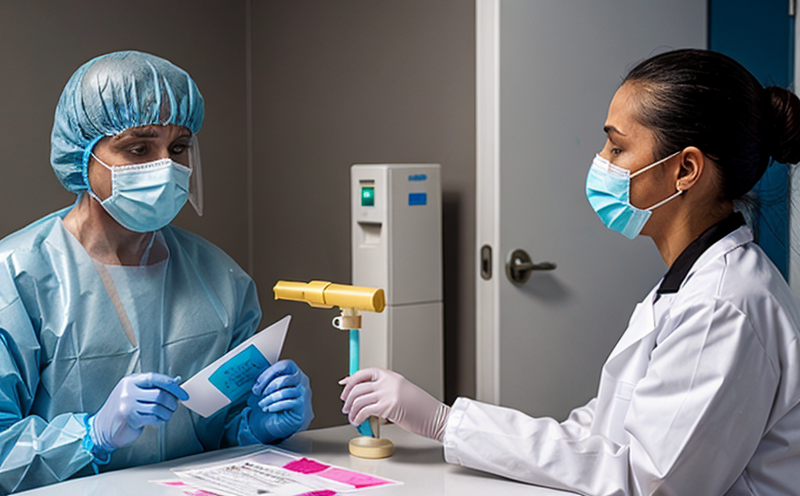Mannheimia haemolytica Testing in Sheep and Goats
Mannheimia haemolytica is a Gram-negative capsular bacterium that belongs to the Pasteurellaceae family. It is one of the primary causes of respiratory diseases, including pneumonia and pleurisy, in sheep and goats. The importance of accurate Mannheimia haemolytica testing cannot be overstated for ensuring animal health and welfare, as well as maintaining the productivity of livestock herds.
The identification and characterization of Mannheimia haemolytica are critical steps in diagnosing respiratory diseases. Proper identification allows for targeted antimicrobial therapy, which is essential for minimizing antibiotic resistance and promoting rapid recovery. In the context of clinical and healthcare testing, accurate identification ensures that appropriate treatments can be prescribed to prevent further spread of infection within herds.
The testing process typically involves collecting samples from affected animals, such as nasal swabs or bronchoalveolar lavage fluids. These specimens are then processed using laboratory techniques like culture-based methods, serological tests, and molecular diagnostics (PCR). Culture-based methods involve inoculating the sample onto selective media that favors the growth of Mannheimia haemolytica. Serological tests measure antibodies against the bacterium, while PCR detects specific genetic material. Each method has its advantages and limitations; for instance, culture-based methods provide a pure isolate but may take several days to yield results.
The importance of accurate testing extends beyond just identifying the presence or absence of Mannheimia haemolytica. It also plays a crucial role in understanding the epidemiology of respiratory diseases. By regularly monitoring herds for this bacterium, farmers and veterinarians can implement preventive measures to reduce the incidence of disease outbreaks. This proactive approach not only improves animal health but also reduces economic losses associated with treatment costs and decreased productivity.
Accurate identification of Mannheimia haemolytica is particularly important in regions where respiratory diseases are prevalent. In these areas, herds may be exposed to multiple stressors that can exacerbate the severity of infections. Early detection through reliable testing allows for timely intervention, which can significantly improve outcomes and reduce mortality rates.
For quality managers, compliance officers, R&D engineers, and procurement specialists involved in animal health management, understanding the nuances of Mannheimia haemolytica testing is essential. Proper identification ensures that appropriate diagnostic tools are used, leading to accurate diagnoses and effective treatment strategies. This knowledge helps stakeholders make informed decisions about herd health management practices.
In summary, accurate testing for Mannheimia haemolytica in sheep and goats is vital for maintaining animal health and preventing the spread of respiratory diseases within herds. By leveraging advanced laboratory techniques, stakeholders can ensure that appropriate treatments are administered promptly, thereby minimizing economic impacts on livestock operations.
| Sample Type | Description |
|---|---|
| Nasal Swab | A swab taken from the nasal cavity of an animal to collect respiratory secretions. |
| Bronchoalveolar Lavage Fluid (BALF) | Fluid collected by lavaging the airways, useful for diagnosing lower respiratory tract infections. |
| Blood Sample | A blood sample may be used in serological tests to detect antibodies against Mannheimia haemolytica. |
Industry Applications
- Veterinary Medicine: Diagnosing and treating respiratory diseases in sheep and goats.
- Agriculture: Ensuring herd health to maintain productivity and reduce economic losses.
- Pharmaceutical Industry: Developing effective vaccines against Mannheimia haemolytica.
- R&D: Studying the pathogenesis of respiratory diseases in livestock.
| Disease | Description |
|---|---|
| Pneumonia | An inflammation of the lungs caused by Mannheimia haemolytica, leading to difficulty breathing. |
| Pleurisy | Inflammation of the pleura, which is the lining around the lungs and inside the chest cavity. |
International Acceptance and Recognition
The testing methods for Mannheimia haemolytica are widely recognized internationally. According to ISO standards, culture-based methods should be used as a gold standard for identifying the bacterium. Serological tests can also be employed to complement these methods. Molecular diagnostics using PCR have gained significant traction due to their high sensitivity and specificity.
Several international organizations provide guidelines for testing Mannheimia haemolytica. For instance, the World Organization for Animal Health (OIE) recommends culture-based methods as part of its diagnostic protocols. The American Veterinary Medical Association (AVMA) supports the use of serological tests and PCR in conjunction with other diagnostic techniques.
Accredited laboratories that perform Mannheimia haemolytica testing adhere to strict quality assurance procedures outlined by these international bodies. This ensures consistent and reliable results, which are essential for making informed decisions about herd health management.
The acceptance of test results is crucial in global trade scenarios where livestock products are exported or imported between countries. Laboratories that provide accurate Mannheimia haemolytica testing play a vital role in facilitating such transactions by ensuring compliance with international standards and regulations.
Use Cases and Application Examples
Veterinary Clinics: A veterinarian at a clinic might use Mannheimia haemolytica testing to diagnose pneumonia in a sheep or goat. The test results would guide the prescription of antibiotics, ensuring that the treatment is effective against the specific pathogen.
Herd Health Management Programs: A quality manager overseeing herd health might implement regular Mannheimia haemolytica testing as part of a routine monitoring program. This helps in identifying potential outbreaks early and taking preemptive measures to prevent them from spreading within the herd.
Vaccine Development: Researchers working on developing vaccines against respiratory diseases could use Mannheimia haemolytica testing to identify the most effective strains for inclusion in the vaccine formulation. This ensures that the vaccine provides broad protection against various subtypes of the bacterium.
R&D Initiatives: Scientists involved in studying the pathogenesis of respiratory diseases could use Mannheimia haemolytica testing to understand how the bacterium interacts with host immune systems. This knowledge can lead to better treatments and prevention strategies.





